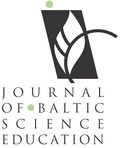ONE HUNDRED CORE CONCEPTS IN CHEMISTRY AND UPPER-SECONDARY SCHOOL TEACHERS’ AND STUDENTS’ CHEMISTRY CONCEPTUAL STRUCTURES
| Title | ONE HUNDRED CORE CONCEPTS IN CHEMISTRY AND UPPER-SECONDARY SCHOOL TEACHERS’ AND STUDENTS’ CHEMISTRY CONCEPTUAL STRUCTURES |
| Publication Type | Journal Article |
| Year of Publication | 2023 |
| Authors | Qian, Y, Wang, Y, Wen, J, Wu, S |
| Journal | Journal of Baltic Science Education |
| Volume | 22 |
| Issue | 3 |
| Start Page | 493-505 |
| Pagination | Continuous |
| Date Published | June/2023 |
| Type of Article | Original article |
| ISSN | 1648-3898 |
| Other Numbers | E-ISSN 2538-7138 |
| Keywords | cluster analysis, conceptual structure, core concepts in chemistry, multidimensional scaling, upper-secondary school students |
| Abstract | A solid grasp of basic concepts and their relationships can stimulate learning motivation, improve teaching quality, and help students to build a body of knowledge in a discipline. Most of the previous studies have considered one chemistry topic amongst many others. To date, no studies have been conducted to explore the conceptual structures of teachers and students based on chemical concepts. Experts, teachers, and students (N=2348) from three public universities and ten upper-secondary schools in China participated in the studies. In Study 1, personal interviews, material evaluation, and importance rating questionnaires were conducted to determine the core concepts. In Study 2, the multidimensional scaling (MDS) and cluster analysis (CA) were conducted to explore the conceptual structures of upper-secondary school teachers and students. Then the structural differences between high- and low-achieving students were compared. The results showed that the three-dimensional solutions were appropriate for the conceptual structures of teachers and students, respectively. The high-achieving students have a more scientific and organized conceptual structure than those of low-achieving students. This study is the first to explore core concepts and their structure with a large sample size, and the reliable results help students understand abstract chemical concepts and improve their interest in scientific disciplines in the future. |
| URL | https://oaji.net/articles/2023/987-1687108348.pdf |
| DOI | 10.33225/jbse/23.22.493 |
| Refereed Designation | Refereed |
| Full Text |
